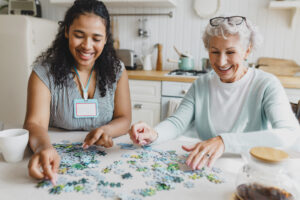Sebastian loved his home. Not only did he build it with his own two hands, it was where he raised his children. For him, home was where his heart was, and he could never imagine leaving it. As he aged, however, Sebastian found it harder and harder to navigate his home the way he used to. The kitchen floor made his joints ache, he had trouble getting in and out of the bathtub, and he could no longer spring up from his favorite reclining chair with ease.
After a visit from his children on his 75th birthday, Sebastian’s eldest son called to tell him that he and his siblings were worried about Sebastian living all alone in his home. They saw how he struggled with mobility and hinted that it might be time to move into an assisted living community that would better accommodate his needs. Sebastian, however, had other ideas. Rather than leave the home he loved, he suggested making some adjustments to make his home work for him as he aged. So together, Sebastian and his son began brainstorming ideas for how to make his home a safer and more comfortable place.
As we age and lose some of our agility, strength, and mobility, the way our homes are designed can become a nuisance and sometimes even be dangerous. Luckily, there are many changes you can make to your aging loved one’s home that will support their desire to live independently. If your aging loved one is living on their own and you feel they could benefit from a few home upgrades to make their space more livable for them, let’s have a look at some aging in place interior design ideas that will make them feel even more at home than they already do.
Aging in Place Interior Design Ideas by Room
Whether your loved one is moving to a new home or renovating an old one, it’s important that it is designed to be comfortable and safe for older adults. Contrary to popular belief, adding a handrail here or a grab bar there isn’t enough; while handrails and grab bars are certainly part of the conversation (more on that in a bit), there are so many more elements of a home that can be adjusted to make aging in place easier.
Let’s move through each room in a house and discuss some of the most important aging in place interior design ideas for each so that you can get inspired and start brainstorming:
- The Kitchen: Aging in place kitchen design is so important, especially if your loved one loves to spend time in the kitchen cooking. It is a good idea to invest in some softer flooring that will be gentler on the joints and make standing more comfortable. Anti-fatigue floor mats are a great option, but make sure that they are non-slip and have a no-curl, beveled edge to reduce the chances of tripping. Investing in a sturdy stool that your loved one can sit on while they cook can work well. Also, consider adjusting lighting to better illuminate the stove or any areas that need more light, such as over the sink as a dimly lit space can increase your loved one’s risk of cutting themselves with a knife while chopping veggies or burning themselves on the stove. If your loved one is in a wheelchair, consider installing a roll-under sink for safer and easier access.
- The Bathroom: Bathrooms can be hard to navigate for many aging adults, but there is a multitude of options for making them more user-friendly. Consider installing a walk-in shower so that your loved one doesn’t need to step over the tub to get in. Shower rails are a great addition to facilitate balance, and seats (permanent or foldable) are a must for older adults who have difficulty standing on their own. Other bathroom design tips include installing a handheld showerhead for better maneuverability and a shelving or a shower caddy to make toiletries more accessible. A comfort height toilet can also make a huge difference for adults with limited mobility. To prevent falls, consider placing non-slip mats on the floor in the shower and replace any slippery floor tile with textured vinyl flooring.
- The Living Room: An uncluttered, efficient living room is best for aging in place, so help your loved one create a clean, simple furniture arrangement that is easy to navigate and keep clear of clutter. As in bathrooms, grab bars can be very useful in the living room, especially on the walls next to the couch or chair where your loved one likes to sit, as they will make it easier to stand up. Lift chairs are another good thing to look into as they also make getting up from furniture safer. If your aging loved one uses a walker, make sure to arrange the room to easily accommodate this so they don’t compromise their stability while maneuvering through the space.
- The Bedroom: Get rid of any throw rugs or mats in the bedroom and replace flooring with soft, plush carpet. Not only will this be easier on your loved one’s joints, it will keep the room warmer and provide friction to prevent falls. Believe it or not, closet organizers may also be a worthwhile investment for your aging loved one if their closet tends to get cluttered; it everything has an accessible place, there is less of a chance your loved one will trip over clothing or shoes or hurt themselves while trying to reach for out of the way items. Also, placing a sturdy chair in or near their closet for them to sit on while they dress can be useful. Electric adjustable beds may also be useful for helping your loved one get up safely in the morning. If their bedroom is upstairs and your loved one has trouble navigating stairs, consider installing a stair lift so they can get to and from their room with ease.
With all these great ideas, it’s tempting to want to get started redesigning your loved one’s home right away. Before you put your hard hat on, however, it’s a good idea to consult with a contractor who is also a Certified Aging in Place Specialist, as they have special training for working with aging adults living spaces. They’ll be able to do an assessment of your loved one’s home and put together a report detailing the modifications they suggest. From there, you and your loved one will be able to identify the most important changes to the interior design of your loved one’s home and when and how to make them.
What a Difference Design Makes
It’s amazing how much difference implementing even a few of the above ideas can make for your aging loved one’s quality and life. Modifying accommodations for comfort and protection will not only help your loved one enjoy their home more, it will help them continue living as safely and as independently as possible.
Once the work on Sebastian’s home was finished, he found that he was much more comfortable in his home than he was previously. Although the interior design ideas that he and his son implemented certainly took some getting used to, he found that he can now move with ease throughout his home and feel empowered doing so. His beloved home, after all, had accommodated him throughout his life, and he was so grateful that it continued to do so as he aged.
Institute on Aging is proud to offer a variety of services and programs that make aging in place easier, safer, and more enjoyable for your aging loved one. To learn more, contact us today.






